The Regional Science Centre and Planetarium, Calicut
Jaffer Khan Colony Rd, Near New Bus Stand, Kozhikode Kerala 673006
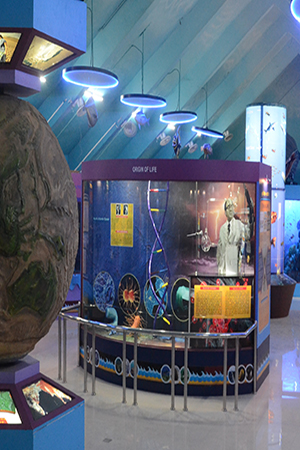
Oceans are a world of mystery, magic and beauty. It covers about 70% of the total surface of the earth. There is an endless array of fascinating and incredibly interesting facts about our oceans. But it is hard to realize
that we have barely touched on the total data potentially available. After countless hours of research and exploration we have found that we know only a fraction of fish, whales,and shark swimming around our shores ,or the squid and shrimp
found in the darkest reaches of our oceans. The Hall of Ocean attempts to provide visitors with a unique and breathtaking introduction to the majesty of the ocean and delve deep into its tantalizing mysteries. Visitors entering the 4800
square feet exhibition hall will welcome by the huge blue whale with its graceful body gestures. By the side of the whale, a cylindrical, section of the ocean depth stands erect towering above all the exhibits in the gallery. It
comprises a variety of bizarre creatures at different levels of the zone. 200 million years ago ,when dinosaurs roamed the earth, all the islands was connected in one giant supercontinent we have named Panagea surrounded by a single enormous ocean
Panthalassa.The exhibit Continental Drift explains how the supercontinent was fragmented and how did the ocean s get where they are today. Scientists know more about the moon than they know about the ocean floor. However oceanographers who study oceans have
recognized many features in the world beneath the waves. Come for a closer watch at the Globe without oceans. Mariana Trench is 11.1 kilometers deep, while Mount Everest is 8.8 kilometers tall. This means that if you placed Mount Everest
at the bottom of the Mariana Trench: the peak will still be 2.3 kilometers below the sea level. The gallery also seeks to explain the rise and fall of the tides, the significance of Estuaries in maintaining ecological balance, phenomenon
of El-Nino &La-Nino, Beaufort scale the measure of wind speed, methods of harnessing power from ocean, navigation instruments and so on. With a surfeit of working models as well as still models ,replicas of sea creatures, marine artefacts,information kiosks, and
digital installations the gallery presents a cosy and inviting ambience. The first MSE on the theme ‘Our Familiar Electricity’ was inaugurated at Ramakrishna Mission Boys’ School, Narendrapur, near Kolkata on 17th November 1965. The first MSE Bus was flagged off in
1966 from Birla Industrial and Technological Museum, Kolkata. In 2019, a set of 25 new buses with new themes of exhibition was launched. These buses were specially meant for the aspirational districts of the state in which the centre owning it
is situated. The new unit attached with RSCP Calicut is on Space Technology for Human Welfare. The unit covers all schools of the only aspirational district in Kerala - Wayanad. Schools of Wayanad are encouraged to contat us for scheduling program
of this unit. You may contact Shri Binoj K, Education officer, RSCP Calicut for this purpose.
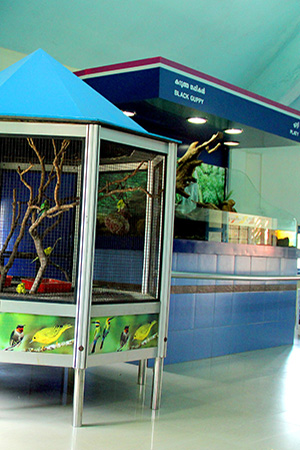
The Life Science Corner is a small live specimen collection. The live collection comprises decorative and exotic fishes including even Prianha that feeds on flesh, Sweet-water Shark, birds, snails and turtles. Even though these animals are in captivity, the breed
here as they are maintained with the help of the Zoological Survey of India. It is a unique opportunity to observe their nature and behaviour from close proximity. We are thrilled to present a summary of the enriching and exciting events
held during International Moon Week 2024 at the Regional Science Centre and Planetarium Calicut. This week-long celebration was filled with diverse activities aimed at inspiring young minds and deepening their understanding of the Moon and its significance. Day 1: Grand Inauguration
and 'Chandravismayam' by Magician Pradeep Hudino The festivities kicked off with a spectacular performance titled 'Chandravismayam' by Magician Pradeep Hudino, followed by the unveiling of our new attraction, 'Selfie with the Moon.' [https://photos.app.goo.gl/vGe4MeHmX7ne4uDz8] Day 2: Scrapbook Workshop on the Moon Students
from grades 4 and 5 participated in a hands-on workshop to create scrapbooks about the Moon and astronomy, combining creativity with learning. [https://photos.app.goo.gl/T4oWqi84Tj9jPK2w6] Day 3: Mono-Act Contest Young performers showcased their talent in the Mono-Act Contest, portraying various aspects of the
Moon through engaging acts. [https://photos.app.goo.gl/ecZZGd8N37nWe5R47] Day 4: Vocal Contest - Songs Inspired by the Moon Talented students sang moon-inspired songs, captivating the audience with their vocal skills and creative interpretations. [https://photos.app.goo.gl/jAFH5HN3nYtZ1xmx5] Day 5: Seminar Contest - 'Modern Moon Race' Students delivered insightful
seminars on the renewed interest in lunar exploration, discussing modern missions and advancements in space technology. [https://photos.app.goo.gl/CoR3e2CEC4U2Yn7YA] Day 6: Workshop - 'Physics of the Moon' Senior secondary students delved into the scientific principles governing lunar phenomena through an interactive workshop. [https://photos.app.goo.gl/RE4UxD5Ujr7y54jD7] Day
7: Prize Distribution and Talk by Dr. Shaneeth M. The week concluded with a grand prize distribution ceremony, honouring the winners of the contests. Dr. Shaneeth M., Scientist at VSSC - ISRO, delivered an inspiring talk titled 'The Moon, The
Mission and Apollo 11,' leaving the audience with profound insights into lunar exploration. [https://photos.app.goo.gl/41sksRXatUQZ2dtN7] Join us in celebrating these memorable moments by exploring the albums of photos and videos from each day's events. We hope this week has sparked a lasting
curiosity and passion for lunar science and exploration among all participants.
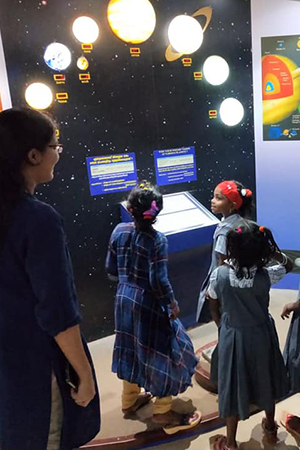
From the Paleolithic Age to the Space Age, we have observed stars, planets, the Sun and The moon and tried to explain their motions. The sky has thus been our clock, our navigation tool and a source of endless wonder.
We have created a world view for naked eye observation, devised the telescope and extended our visible universe. This has led to another worldview and that demanded another game-changing instrument. Throughout the evolution of astronomy, synergy of imagination and instrumentation
have played complementary roles. The Permanent Gallery on Astronomy in the RSCPC, we have shown the play of this intermingling. A story that unfolds how our seeing got us believing in one universe. How instruments changed it to include many
more intricacies – the Cosmic Bakground Radiation to Dark Matter and Dark Energy that still not fully understood. This gallery depicts the developments in our understanding of the sky and celestial objects, a gradual development of astronomy through ages. It
elaborates on various astronomical concepts starting at the pre-telescopic era, then passing through the post-telescopic period, it ventures into the astrophysics of earth and moon and concludes with the quest of human mind in search of the cosmic truth. There
is the observatory of Tycho Brahe with full size sextant; the Indian Astronomy exhibits, the telescope section, the surface of moon where you can pose as an astronaut and see your image in a digital display; then there are sections
on eclipses, tides, solar system, deep-sky objects, the celestial sphere, the Foucault pendulum and much more. The gallery also highlights the location of various Indian observatories. A unique place where one can discover our universe and visualize a cosmic perspective.
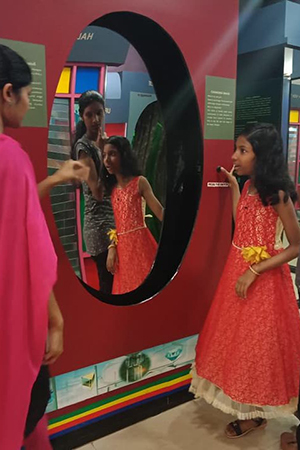
History of mirrors dates back to ancient times when mankind first noticed reflections in still water. Long before man was able to make glass mirrors, polished metal was used to observe images. Greco-Romans used convex disks of metals like bronze,
tin silver etc for various applications. The earliest mirrors were hand mirrors. Mirrors large enough to reflect the image of whole body did not appear until 1st century AD.The chemical process of coating a glass surface with metallic silver was
invented by Justice von Liebig in 1835 which resulted in modern techniques of mirror making. Mirrors make rooms come alive and add magic to a room. They visually expand small areas, and add depth to existing decor. When one mirror
can create so much interest in us, imagine the effect of combination of them would provide. We all are aware that mirrors that are flat. What happens when it is curved? What manifestations does varying the magnitude and direction of
curvature of a mirror create? What happens when several mirrors are placed at different angles to each other? The Mirror Magic gallery provides opportunity for exploring all such manifestations and experiencing them. Visitors can walk through a maze created with
mirrors as well as dine with several images of their own in this gallery. They can also have fun by looking at their distorted images at Fun mirrors as well as learn the science behind why concave mirrors shorter. In
the gallery you can have several experiences like floating in air, vanishing image, tunnel of infinite depth. Kerala’s legacy of world renowned technology of unique metal mirrors is indeed an evidence of its rich culture and metallurgical traditions.”Aranmula Kannadi” is
a standing example of this which is evidenced by its presence at renowned museums worldover. The Mirror magic gallery is full of interest stimulating experiences through interactive exhibits and also explains scientific principles involved in mirror optics.
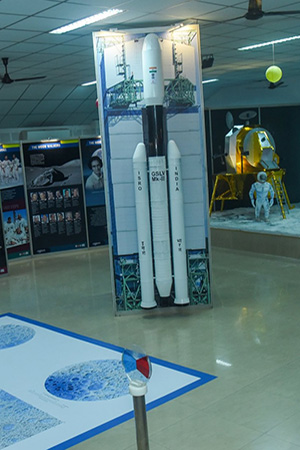
This exhibition is no longer on display. But it is archived for hiring. Any Educational Institutions may hire it for two days, a week or two weeks at a nominal cost of Rs. 30,000; Rs. 50,000 and Rs. 70,000 only.
the trasport cost and logistics are under the scope of the hosting orrganisation where as RSCPC takes care of installation and demonstration during the period of display. There’s a certain closeness and kinship in the distance of the moon. We
share a fundamental partnership, like an electron and a hydrogen atom—seemingly intertwined by definition. For what would our world be without the moon in our skies? To wax and wane, to trim the tides, to mark our calendars and inspire
our art, to light our nights, in anchoring our place in space. The moon represents a delicate balance in nature. It is not only a rock, but a metaphor, a simile, and a poem. It was our first daring expedition
target beyond our planet, and though we haven’t been back in decades, a select few men setting foot on its surface fundamentally changed how we saw ourselves, both figuratively and literally. It embodied our genetic trait to do it first
by outperforming others. In 1969 we the human race reached The Moon to be first time out to another world physically. In 2019 as a nation our robotic probe is going to revisit Moon surface within a few days. It is
a moment to commemorate the history, the audacity and to know the technology that was and that is driving us still to touch down the Moon. This exhibition welcomes you with all the potential to know the Moon and those
deeds of human ingenuity to achieve a splendid rendezvous with it. This Exhibition was on display for 2 months. Following its tenure it travelled several Educational Institutions of Kozhikode.
Science is a subject dealt with allseriousness in schools. This descriptive approach may make it uninteresting to an impressionable mind who look for more inquisitive treatment. This gallery takes another approach. Roll a ball here, spin a wheel there and
many magical effects happen which asks for explanations. A whole world of wonder and amazement awaits the visitors here with many interactive hands-on exhibits. The motto of this gallery to encourage one and all being curious. Can you sit on single
nail? How can you sleep on a nail bed. Do you like to know the science behind this? Visit the Fun science gallery for getting the answers. This gallery describes the fundamental principles of physics in simple way. How ball floats in air
defying gravity, Formation of eddy currents, lazy channel etc. are well explained in the gallery.